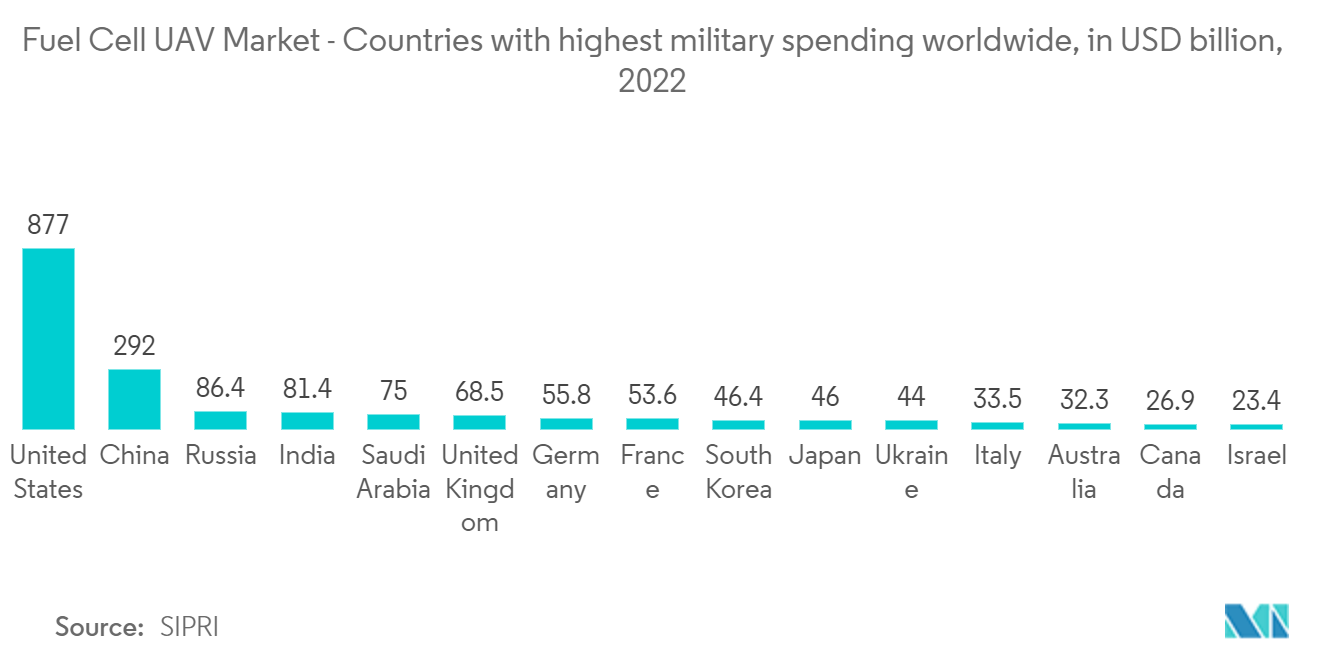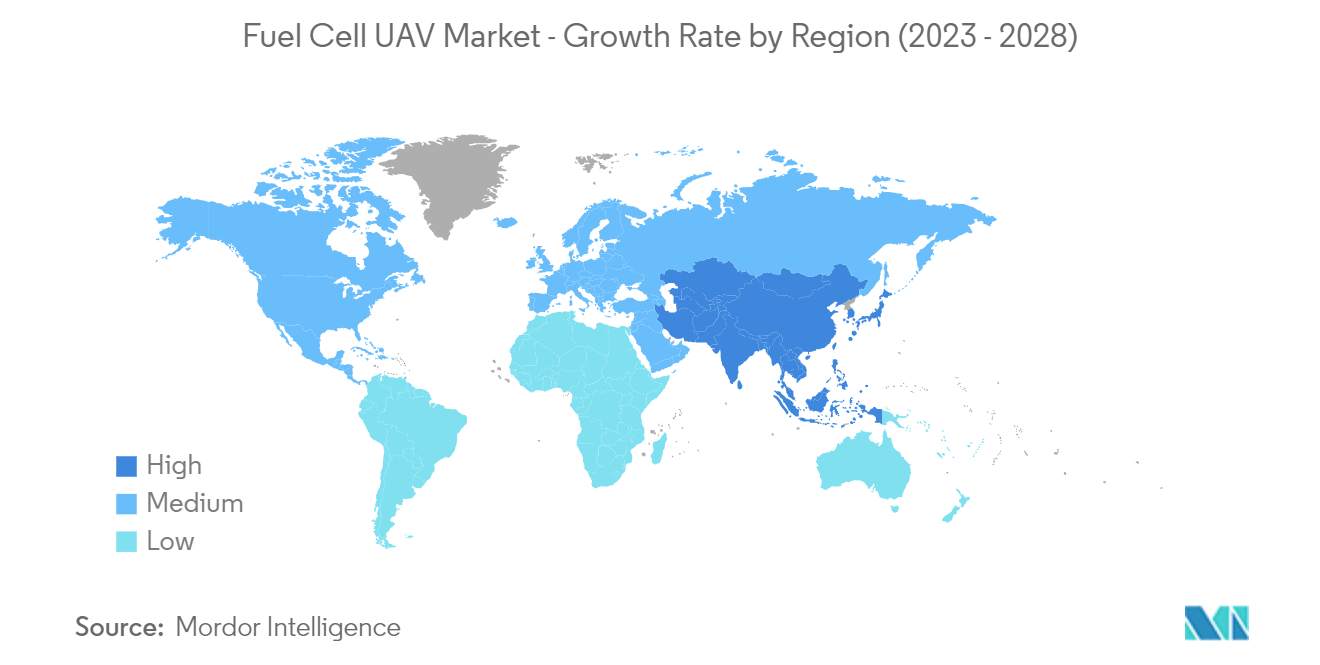Market Trends of Fuel Cell UAV Industry
The Military Segment is Anticipated to Grow with the Highest CAGR During the Forecast Period
- The military segment is expected to show significant growth during the forecast period. The main factors which are attributable to such growth include an increase in the budget of various defense forces worldwide and the increased need for advanced fuel cell UAV systems by various military personnel to carry out critical battlefield missions, and it is expected that these factors will contribute to market growth in the near future.
- The military sector has a high demand for advanced UAV technologies to enhance surveillance, reconnaissance, and combat capabilities. Fuel Cell UAVs offer extended flight endurance, stealthy operations, and reduced logistical burden, making them well-suited for military applications. Additionally, the military sector has the necessary resources and budget to invest in cutting-edge technologies, which in turn leads to the segment gaining a critical advantage in the market.
- Applications of fuel cells range from powering soldier gear to flying unmanned aircraft, and fuel cells are currently becoming an attractive option for defense personnel worldwide. Fuel cells can increase the airtime of drones by hours and charge in just minutes. Unmanned aerial vehicles (UAVs) are typically used for military operations where manned flights would be too risky or difficult. Moreover, the growing complexity of battlefield scenarios has led to an increase in the usage of UAVs by defense personnel of various countries worldwide in order to carry out critical mission functions.
- The necessity of making use of UAVs by the military segment has led to an increase in the number of investments by various defense manufacturers around the world who are now focusing on finding out alternative sources of energy to power UAVs and develop advanced fuel-cell systems. In addition, developments in military technology and rising public-private collaborations are expected to offer lucrative opportunities in the military segment.
- In the current scenario, advanced technologies such as hydrogen-powered drones are being adopted in the military segment. For instance, in February 2023, an Israeli company announced that they are working with the Israeli MoD n supplying drones fueled by hydrogen that can carry payloads that are larger than what traditional quadcopters can handle and for greater distances. Moreover, in May 2019, a Russian film announced that they are bringing a Gjis UAV, a drone powered by hydrogen fuel cells, to the massive Army-2019 exposition. The UAV, which has been made by International Aero Navigation Systems Concern, boasts an altitude ceiling of at least 9,800 feet, a 3-mile operational radius, and a cruising speed of over 35 mph. Moreover, the advantage of using a hydrogen-powered UAV is that it can operate without additional logistics or fuel infrastructure as users have to simply pour water into a fuel cartridge, and the resulting reaction releases hydrogen that can power this UAV for several hours. Thus, advancement in terms of technological developments regarding fuel cell systems and the increasing need for the adoption of advanced fuel cell UAVs by various defense personnel worldwide is expected to lead to the fuel cell UAV market witnessing significant growth in the military segment during the forecast period.

Asia-Pacific Will Showcase Remarkable Growth During the Forecast Period
- Asia-Pacific is projected to show the highest growth during the forecast period. The increase in the budget of various countries in the Asia-Pacific region, coupled with technological advancements in terms of drone technology and fuel cell technology by countries such as India and China, as well as the need for acquiring advanced fuel cell UAV systems by these countries, will propel the growth in the market in the years to come.
- There has been growth with regard to high-tech military hardware acquirement in the Asia-Pacific region by countries such as China and India. China is witnessing significant developments with respect to fuel cell UAV systems. The presence of various manufacturers in China has led to China having an advantage with regard to technological research and product development. Moreover, China is investing heavily in the development of drones having advanced capabilities. For instance, in March 2020, China announced that it had achieved a world record flight time for a hydrogen fuel cell drone. According to trusted business sources, a research drone that had been developed by Xinyan Chuangneng Technology Company Ltd., together with China National Airways, announced that they had achieved an uninterrupted outdoor flight of up to 331 minutes. The collaboration between the two companies has resulted in the development of a six-rotor hydrogen fuel cell drone that can fly for 331 minutes. This achievement has broken the world record and has put China at the forefront in terms of the development of hydrogen fuel cell systems. In addition, the core technology of the drone is a hydrogen fuel cell which is equipped with a high-pressure hydrogen storage bottle to provide hydrogen for the hydrogen fuel cell in order to generate the necessary electricity. Moreover, both the collaborating companies have claimed to successfully develop a 2kW metal plate cell air-cooled stack and system with a small size, excellent performance, and lightweight, with high power density, which has been successfully integrated into the drone.
- India has also been witnessing growth in fuel cell UAV systems in recent years. In the present scenario, India has entered several partnerships with advanced drone and fuel cell manufacturers in order to upgrade their drone and fuel cell technologies. Moreover, India has now also emerged as a key testing ground for hydrogen fuel cell-powered drones of various global market players. For instance, in August 2021, Honeywell Corporation announced that they had developed a new technology that would increase the range of drones by three times with cleaner, quieter hydrogen fuel cells, and such drones will be tested in India. The drone will be developed by making use of a new 'technology suite' that will allow these drones longer flight hours and with less human intervention. Moreover, compared with traditional drones using batteries and line-of-sight radio links, drones equipped with Honeywell's Beyond Visual Line of Sight (BVLOS) technologies can fly farther, carry more weight, avoid hazards up to three kilometers away, and stream video of their progress anywhere in the world. Thus, advanced technological development with regards to fuel cell UAV systems in countries such as China and India and the need for the development of advanced drone systems will have a positive outlook and will lead to the fuel cell UAV market witnessing significant market growth in the Asia-Pacific region during the forecast period.

